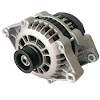A Generator is a rotating machine, which converts mechanical energy supplied to it into electrical energy. For production of dynamically (or statically) induced e.m.f the following three things are essential.
1. Magnetic field (flux)
2. Conductor (or coil ) and
3. Relative motion between field and conductor.
In D.c. Generators the flux is produced by the stationary
field magnets. Where as conductors are situated on the periphery of the
armature being rotated by the prime mover, the e.m.f induced in the armature conductors, according
to faradays laws of electro magnetic induction and is known as dynamically
induced e.m.f. The arrangement of field system and conductors is vice-versa in
a.c. generators or alternators.
Flemings Right Hand
Rule
Flemings Right Hand Rule is Used to determine the direction of induced currents in a conductor/coil (i.e. in generators). “Place the fore-finger (first finger), middle-finger (second finger) and thumb of the right hand mutually perpendicular to each other such that, the fore-finger should point the direction of magnetic field and thumb should point the direction of motion of the conductor then the middle finger gives the direction of induced current flowing in the conductor.”
Electromechanical energy
Conversion
The chief advantage of electrical energy over other forms of
energies is the relative ease and high efficiency with which it can be
transmitted over a long distance. Electric energy is seldom available naturally
and is rarely used directly. Its main use is in the form of a transmitting link
for transporting other forms of energy e.g. light, mechanical, heat, sound
etc., from one physical location to another. Obviously two kinds of energy
conversion devices are needed-to convert from one form of energy to the
electric form and to convert from one form of energy to the electric form. Our aim
in this article is to understand the devices used for electromechanical energy
conversion.
These devices can be
1. Transducers for processing and transporting low-energy signals.
2. Production of force or torque with limited mechanical motion like electromagnets, actuators, relays etc.
3. Continuous energy conversion devices likes motors, generators for bulk energy conversion and utilization.
We concentrate on the principles of electromechanical energy
conversion and the analysis is placed on the analysis of systems which use
magnetic fields as the conversion medium. However, the analytical techniques
for electric field systems are quite similar. The purpose of this analysis is
three fold:










0 Comments